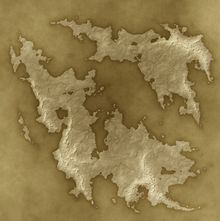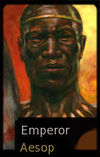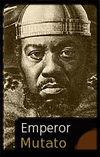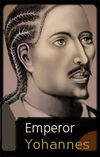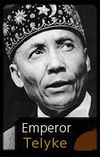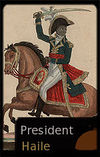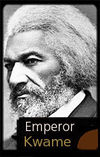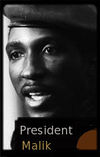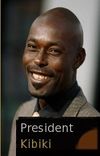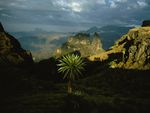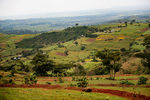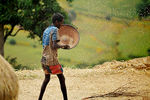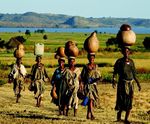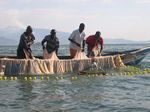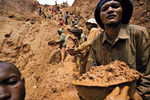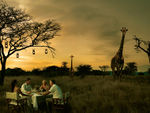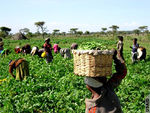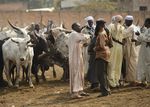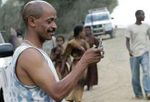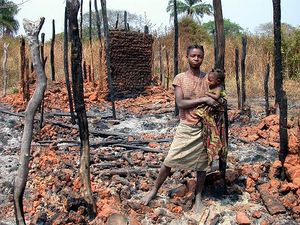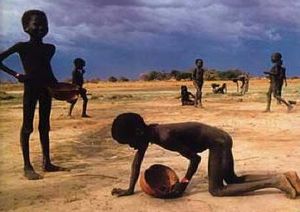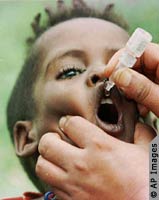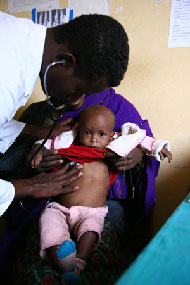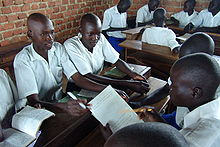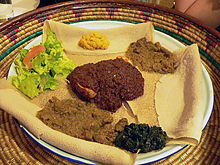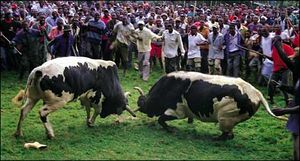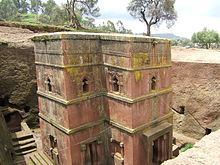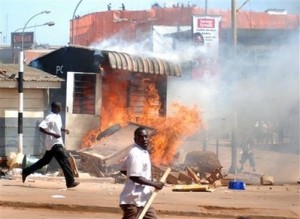Nation/Miskitu
| This page is a work in progress by its author(s) and should not be considered final. |
| The Republic of Miskitu | ||||||
|---|---|---|---|---|---|---|
|
||||||
| Motto: The awareness of our own strength makes us modest | ||||||
| Anthem: Anthem of Miskitu | ||||||
| Official languages | Miskitese | |||||
| Primary Language(s) | Miskitese | |||||
| Ethnic groups (2014) | Unknown | |||||
| Demonym | Miskitese | |||||
| Government | Republic | |||||
| - | President | Laurent Kibki | ||||
| Currency | Miskitese Dime | |||||
| Date format | dd-mm-yyyy | |||||
| Calling code | +371 | |||||
| Internet TLD | .mk | |||||
Miskitu (miss-KEE-tu), officially the Republic of Miskitu, is a nation lying just south of the tropic of Capricorn. It consists of two main islands and numerous smaller ones.
Miskitu takes its name from the native Miskitu tribes of the islands although in many parts of the world it is miss-translated as Mosquito.
The people of Miskitu were hunter-gatherers until around two thousand years ago, when several tribal populations migrated and settled permenantly in the southern parts of the country. The official language is Miskitese, although multiple other languages are spoken in the country. The current president is Laurent Kibiki.
Miskitu has a mixed climate. The temperate in the lowland areas near the coast is warm and dry with malerai and other mosquito born desieses rampant in these regions.The central areas of both islands are dominated by the cool, temperate Miskitu highlands. Areas of arid and semi-arid lands with near-desert landscapes contract with fertile wildlife rich valleys and ice capped peaks.
Miskitu has been an Imperial Monarchy for most of its history. The title of Emperor dates back to the early Empire on the islands, created from the Miskitu military campaigns of Aesop, then a tribal ruler which unified the various warring tribes with the title remaining in use throughout the nations history.
Several dynastyies have ruled pver the nation broken by periods of intermittant republicanism. The Monarchy was last overthrown with outside support in the mid 20th century and the then Royal Family fled overseas, where they still live and retain strong support among some elements of the people for their restoration. The period since then has been marked by intermittent conflicts, most recently a civil war.
The majority of the population is Methodist but there are strong populations of other religions.
Miskitu has undergone a series of famines from the 1980s until today, exacerbated by adverse geopolitics and civil wars.
Contents
Etymology
The name "Miskitu" derives from the Miskitese name for themselves. It is not related to the word mosquito, which derives from the word mosca, meaning "fly". Early visitors, however, often mistaken refared to the islands as Mosquito, perhaps due to the regular influx of mosquitoes and historical problems with maleria in the area. The name was marked on early navigation charts as "Mosquito" and has remained as such in several languages.
History
Antiquity
The people of Miskitu were hunter-gatherers until 1,700 to 2,300 years ago, when several tribal populations migrated to the southern parts of the country. Around the 3rd century BC, a kingdom was established on the southern Miskitu islands. Its capital was around the current town of Kibi, the kingdom was short lived and the tribes fractured after only several generations. After the fall the islands came to be dominated by smaller successor kingdoms, until the rise of one of these kingdoms during the 1st century AD, now referred to as the second Miskitu Kingdom. The Miskitu established bases on the northern highlands and from there expanded southward.
By around 500 AD sailors from the north, trading with the Miskitus brought Christianity to the nation and it began slowly spreading through the nation. The Kingdom lasted until 659 AD at which time disputes and fractures within the royal family ultimately led to its collapse with the various competing family members forming smaller tribal kingdoms.
Middle Ages
From the 11th to 17th century the lands were part of a far greater Kingdom, centered on Sodan, known as the Greater Miskitu Kindom (also called the third Miskitu Kingdom)
The Kingdom was formed by the tribal chief Yohannes, a blood thirsty warrior who is thought to have massacred almost half the Miskitu tribes as he reunified the nation. His son Yohannes II completed the conquest of the islands and extended his power to the mainland. Despite its beginning this era was known as the golden age for Miskitu civilization. They was relative peace in the Kingdom, few enemies and trade flourished.
Despite its apparent strengths, the Kingdom was built on a shaky foundation. It relied almost entirely on good and supplies from the new territories to supply the Miskitu homeland. In 1671 AD a series of rebellions on the mainland territories forced the Miskitus to withdraw to their homeland islands. The army rebelled against the Royal family and the commander Telyke assumed command of the nation.
Telyke Sultanate
The Telyke Sultanate succeeded the Kingdom. Having overthrown the Greater Empire, Telyke declared an Islamic Sultanante. Therein began a period of isolation, the Sultanate was far more focused on internal affairs then external and began to try and institute Islamic law. However the Muslims were by far in the minority in the nation, with only about 5% of the people accepting the faith. Religious tensions almost tore the nation apart and despite a bloodthirsty reign by Telyke his power crumpled and with it the nation.
The Fourth Kingdom
Tribal divisions lasted until 1714 when a treaty united the various factions. Abbas was declared the High King of the Miskitu Tribes and ended Miskitu isolationism. Upon his ascent, he began modernizing Miskitu and recentralizing power in the King, and Miskitu began to take part in world affairs once again.
But Abbas suffered several rebellions inside his Kingdom, as was so often the way he turned to repression and put down these uprisings by force. It is though almost 50,000 people died before the Kingdom was fully united. Upon completing this feat, Abbas declared himself Emperor and took the name Yohannes V after the Kings of the third Kingdom.
At the same time there were also advances in road construction, electricity and education, development of a central taxation system, and the foundation and building of the city of the modern Sodan. The Great Miskitu Famine of 1911 to 1924 cost it roughly one-third of its population. The fourth Kingdom lasted until 1948 when the Great Powers caused its collapse.
The Modern Era
Following the collapse of the Empire in 1948 there has been little stable government in Miskitu. The nation has gone through periods of republic (1848 -1956, 1969 – 1973, 1989 – 1994, 2007 - present), military rule (1956 – 1969, 1981 – 1984, 1994 - 2007), socialist (1973 – 1981, 1984 – 1989).
There was a civil war raging from 1994 – 2007 which has cost many lives and is still on-going in smaller pockets around Miskitu today. This was inspired by the different ideologies and regional alliances which has also seen the collapse of numerous governments.
This has coupled with a famine from the 1980 till today which has devastated the nation’s health, agriculture and coupled with the accompanying diseases has crippled the nation.
The current is Laurent Kibiki who has held power since 2007.
Geography & Enviroment
The 580,000 km2 lands of Miskitu are spread accross two major islands and numerous smaller ones.Tropical coastal lowlands rapidly give rise the vast Miskitu highlands. These upland areas dominate the two main islands and give rise to a unique climate for the nations latititute, with a cooler then expected climate in many areas. Large areas are arid and semi-arid deserts and several snowcapped mountains can be found. This contrasts with the warm dary lowlying costal regions.
Climate
The predominant climate type is tropical monsoon, with wide topographic-induced variation. The Highlands have a climate which is generally considerably cooler than other regions at similar proximity to the Equator. Most of the country's major cities are located at elevations of around 2,000–2,500 m (6,562–8,202 ft) above sea level. While some higland areas offer little more then arid scubland many of the valleys offer rich soils and vast quantities of wildlife. This contracts with the highest peaks which are permentantly ice capped,
The average annual temperature is 16 °C (60.8 °F), with daily maximum temperatures averaging 20–25 °C (68–77 °F) throughout the year, and overnight lows averaging 5–10 °C (41–50 °F).
Most major cities traditionally lie at high elevations and have a comparable climate. In less elevated regions, particularly the lower lying costal regions the climate can be significantly hotter and drier, leading to sparsely populated areas where mosquito born desiese is rampant.New beach front tourist areaas have begun to sping up, ranging from shanty dwellings to luxery resorts.
Wildlife
- Baby baboon on back.jpg
Baboon
- Bouquetins combat.jpg
Ibex
- Crocuta crocuta.jpg
Hyenea
- Gorilla gorilla11.jpg
Gorilla
- EthiopianWolf1.jpg
Miskitese Wolf
Miskitu has a large number of endemic species, notably the Baboon, the Ibex, Hyenea, Gorilla, Monkeys and the wolf. The wide range of altitude has given the country a variety of ecologically distinct areas, this has helped to encourage the evolution of endemic species in ecological isolation.
Miskitu has 31 endemic species of mammals. Wildlife populations have been rapidly declining owing to logging, civil wars, pollution, poaching and other human interference, A long civil war along with severe drought, negatively impacted environmental conditions leading to even greater habitat degradation. Habitat destruction is a factor that leads to endangerment. Human impact threatens many species as a result of climate change induced by greenhouse gas emissions.
There have been recent efforts to transform several areas into nature reserves for tourism purposes. Poaching and continued deforestation have led to mixed results.
- African Bush Elephant Mikumi.jpg
Elephant
- LycaonPictus.jpg
Wild Dog
- Lion waiting in Namibia.jpg
Lion
- Zebras etoscha.jpg
Zebra
- Giraffe standing.jpg
Giraffe
- Mantled Guereza.jpg
Guereza Monkey
Hunting
There are few protected areas in Miskitu and hunting has become a serious problem. The hunter gather mentality has been part of the nations hritage since its inception however combined recent industrial scale hunts have virtually wiped outseveral species including the vuirtually extint Miskitese wolf. As the number of predators has fallen so to has the number of grazing animals, such as rabbit and hare, increased which has led to overgrazing of the little grass and further enviromental damage.
Recent efforts to regulate the trade have met with limited success.
- Crocodylus niloticus in Lake Chamo 02.jpg
Crocodile
- Cheetah Feb09 02.jpg
Cheetah
- Waterberg Nashorn2.jpg
White rhinoceros
- Hippo mouth.jpg
Hippopotamus
- Side-striped Jackal.jpg
Jackal
- Tarangire Warzenschwein1.jpg
Warthog
Deforestation
Deforestation is a major concern for Miskitu as studies suggest loss of forest contributes to soil erosion, loss of nutrients in the soil, loss of animal habitats and reduction in biodiversity. At the beginning of the 20th century around half of Miskitus land was covered by trees but recent research indicates that forest cover is now approximately 12% of the area. Adding to the problem is the increasing demand for land for coffee production.
Current government programs to control deforestation consist of education, promoting reforestation programs and providing alternate raw material to timber. In rural areas the government also provides non-timber fuel sources and access to non-forested land to promote agriculture without destroying forest habitat.
Deadly Animals
There are numerous animals in Miskitu which can be considered deadly to humans. While large mammels such as lions are often considered as deadly creatures, the truth is that while some such as hippo's and elephants can and do cause human deaths, the most deadly animals are the smaller snakes, scorpions. Spiders while numerous are rarely deadly. The most deadly animal by far is the disease spreading mosquito. It is estimated that three-fourths of the land below 2000 meters is malarious with a significant percentage of the country’s population at risk. This makes malaria the number one health problem in Miskitu with an average of 3 million cases a year. The disease causes 30,000 deaths each year.
- Mosquito 2007-2.jpg
Mosquito
- Black scorpion.jpg
Black Scorpion
- Deathstalker ST 07.JPG
Deathstalker Scorpion
- Indiancobra.jpg
Miskitu Cobra
- Kopf einer Puffotter.JPG
Puff Adder
- Dendroaspis polylepis by Bill Love.jpg
Black Mamba
Economy
For decades, Miskitu's economy suffered from devastating economic policies and instability, leaving Miskitu as one of the world's poorest countries. The economy of Miskitu is largely based on agriculture, which accounts for 50% of the gross domestic product (GDP) and 80% of total employment. Its economy is fast growing however , despite some reforms, poorly structured and subject to mass corruption and inefficiencies.
Almost 50% of Miskitu's population is under the age of 18, and even though education enrollment at primary and tertiary level has increased significantly, job creation has not caught up with the increased output from educational institutes. Production is overwhelmingly by small-scale farmers and enterprises and a large part of commodity exports are provided by the small agricultural cash-crop sector. The country must create hundreds of thousands of jobs every year just to keep up with population growth.
The Miskitun constitution defines the right to own land as belonging only to "the state and the people", but citizens may only lease land (up to 99 years), and are unable to mortgage, sell, or own it. Various groups and political parties have sought for full privatization of land, while others are against privatization and favor communal ownership.
Since the fall of the Monarchy the government has embarked on a modest program of economic reform, including privatization of state enterprises and rationalization of government regulation. Despite this, agricultural productivity remains low, and frequent droughts still beset the country. While the process is still ongoing, the reforms have begun to attract much-needed foreign investment.
Miskitu has a large diaspora who contribute enormously economic growth through remittances and other investments (especially property). However Miskitu still relies massively on aid and humanitarian agencies for much of its funds.
Growth has not always led to poverty reduction. Despite an improving average annual rate, poverty levels have increased simultaneously. Urban and especially rural poverty remains an issue in the country. With an exploding population Miskitu remains one of the poorest nations in the world.
The life expectancy of men is reported to be 56 years and for women 59 years.
Primary sector
Agriculture
The economy of Miskitu is based on agriculture, which accounts for 40% of the gross domestic product (GDP) and 80% of total employment. Miskitu's agriculture is plagued by periodic drought, soil degradation caused by overgrazing, deforestation, high population density, high levels of taxation and poor infrastructure (making it difficult and expensive to get goods to market). Yet agriculture is the country's most promising resource. A potential exists for self-sufficiency in grains and for export development in livestock, grains, vegetables, and fruits.
Many other economic activities depend on agriculture, including marketing, processing, and export of agricultural products. Production is overwhelmingly of a subsistence nature, and a large part of commodity exports are provided by the small agricultural cash-crop sector. Principal crops include coffee, pulses (e.g., beans), oilseeds, cereals, potatoes, sugarcane, and vegetables. Exports are almost entirely agricultural commodities, with coffee as the largest foreign exchange earner, and its flower industry becoming a new source of revenue. Miskitu's livestock contributed to 20% of total GDP.
Traditionally most land has been divided into small family run plots however recently land has been concentrated by both large international companies and richer nations for food production and export. This has raised fears of food being exported to more prosperous countries while the local population faces its own shortage.
Up to 20% of the population need food assistance annually.
Forestry
At the beginning of the 20th century around half of Miskitu's land was covered by trees but recent research indicates that forest cover is now approximately 12% of the area. This forest destruction has been largely unplanned and generated little long time income. As the forests are removed the soils became less fertile and crop growth potential is limited. Most land has been cleared for further expansion of the coffee industry.
Fishing
Despite its extensive coastline, due to the heat and disease from mosquitoes the majority of the Miskitu population lives in the highlands. Fishing has traditionally been a limited economic activity limited to several small coastal communities. Efforts have been made to expand this sector and include licensing several large international fishing operations which in turn have contributed to the growth of shore based local industries.
Secondary sector
Manufacturing
This sector constitutes about 5 percent of the overall economy, although it has shown some growth and diversification in recent years. Much of it is concentrated in Sodan. Food and beverages constitute some 40 percent of the sector, but textiles and leather are also important, the latter especially for the export market. A program to privatize state-owned enterprises has been underway since the fall of the monarchy.
Minerals and Mining
The mining sector is small but offers huge potentail in Miskitu. The country has deposits of coal, opal, gemstones, kaolin, iron ore, soda ash, and gold, but only diamonds are mined in significant quantities. It is estimated that there is significant potential for future development of the diamond mining sector but is so far limited to local companies who agreed deals for the mines following the collapse of the Monarchy. Salt extraction is only of internal importance and only a negligible amount is exported. Mining is considered one of the most dangerous industries in Miskitu with little automation of the sector.
Tertiary sector
Travel and tourism continue to become extremely important and aside from wholesale and retail trade, transportation, and communications, the services sector consists almost entirely of tourism.
Developed over the past century under the Monarchy growth has been constrained by the lack of suitable hotels and other infrastructure. A significant investment was made in this area however the droughts of the 1980's onwards caused the industry to crash. Many hotels and restaurants now sit empty and in ruin. At the time this created huge anti-monarchist sentiment and was in part contributed to their fall. The majority of tourists entering the country today are Miskitese visiting from abroad.
Given the abundence of wildlife there is significant potentail for future growth should the ongoing infasture concerns be solved. Some reports credit tourism as the future of Miskitu. Local and international companies have begun to tap into this sector but to date have been limited by a profound lack of government commitment to upgrading national facilities.
The banking and insurance sectors performed are extremely limited and protected by national regulations which has limited the potential for growth through foreign development.
External trade
The major agricultural export crop is coffee, providing about 40% of Miskitu'sGDP. Coffee is critical to the Miskitun economy. More than a third of the population derive their livelihood from the coffee sector.
Other exports include live animals, maize, leather and leather products, chemicals, gold, pulses, oilseeds, flowers, fruits and vegetables and khat (or qat), a leafy shrub which has psychotropic qualities when chewed.
Additional small-scale export products include cereals, pulses, cotton, sugarcane, potatoes and hides. The country also has large mineral resources including diamonds and gold as well as oil potential in some of the less inhabited regions. Hydroelectric and geothermal power production represents an area of potential future development. However political instability and corruption has inhibited development.
Cross-border trade by pastoralists is often informal and beyond state control and regulation.. This unregulated trade in livestock is thought to represent more then 80% of all imports and exports to the nation. This trade helps lower food prices, increase food security and relieve border tension. However, there are also risks as the unregulated and undocumented nature of this trade runs risks, such as allowing disease to spread more easily across national borders. Furthermore, the government of Miskitu is purportedly unhappy with lost tax revenue and foreign exchange revenues. Recent initiatives have sought to document and regulate this trade.
Dependent on a few vulnerable crops for its foreign exchange earnings and reliant on imported oil, Miskitu lacks sufficient foreign exchange. Since the overthrow of the monarchy the government has been notably financially conservative government has taken measures to solve this problem, including stringent import controls and sharply reduced subsidies on retail gasoline prices. Nevertheless, the largely subsistence economy is incapable of supporting high military expenditures, drought relief, an ambitious development plan, and indispensable imports such as oil; it therefore depends on foreign assistance.
Transportation
Available modes of transport are by road, sea, and air although most are in poor condition. Miskitu has 681 km of railway and trains represent the most popular form of transport for both goods and people however trains are antiquated, dangerously overcrowded and slow with a poor safety record.
Less then ten percent of the roads are paved and those that are are in the hands of private toll companies. Many unpaved roards are little more then cattle paths and are unusable in poor weather. Per capita private car ownership is extremly low in rural areas and mainly concentrated in cities where numerous older vehicles contribute to poor air quality. Driving standards are poor and enforcement of the traffic regulations virtually non existant.
Several regional airports are liked to Sodan International, a modern International airport linking Miskitu to numerous other nations.
Communications
Miskitu Telecom is a monopoly in the control of telecommunications and Internet connections on the islands.
As of 2010, 3.2 million cellular phones and 200,000 main line phones were in use, however the vast majority of these are in the cities. There are an estimated 150,000 Internet users, one of the lowest rates in the world. Miskitu's country code is .mk.
The average rural inhabitant of Miskitu has to walk 40 kilometers to the nearest phone. The government has announced a plan to reduce this to ten kilometers however little work has begun to achieve this goal.
The telecommunication network is frequently out of work or overloaded, callers using both the landlines and mobile network are unable to connect, the situation is made worse by inclement weather.
Energy
Hydropower accounts for the bulk of Miskitu's electric power generating capacity and output which currently stands at 80% of the nations supply.
In 2010 less than 10% of Miskitese had access to electricity and the country was plagued by power outages. In order to overcome this situation, the government has embarked on an ambitious dam building program. With massive water resources in its high plains, Miskitu has the capacity to generate up to 45,000MW of hydropower, although current production stands at around 2,000 MW mainly due to poor construction, inefficiencies and financial costs. However, Miskitu's heavy reliance upon hydropower to supply its electric power has made the country vulnerable to lengthy droughts and climate change has made such reliance on one resource risky.
As such Miskitu’s ambitious growth and diversification plan, which started in 2010, aims to increase the existing 2,000 MW generated by geothermal power production at least fourfold.
Although Miskitu has few proven hydrocarbon reserves, it is estimated to have considerable potential for oil and gas exploration.
Poverty
Miskitu is one of the poorest nations in the world, with 40 percent of the population living on less than $1 a day. Despite making some progress in reducing the countrywide poverty it remains deep-rooted in the country’s rural areas, which are home to more than 85 per cent of people.
Women's poverty
People in rural areas of Miskitu depend on farming as the main source of income and 90 per cent of all rural women work in the agricultural sector. In addition to agricultural work, rural women also have the responsibility of caretaking within their families. The average woman spends 9 hours a day on domestic tasks, such as preparing food and clothing, fetching water and firewood, and caring for the elderly, the sick as well as orphans. As such, women on average work longer hours than men, between 12 and 18 hours per day, as compared to men, who work between 8 and 10 hours a day.
To supplement their income, rural women may engage in small-scale entrepreneurial activities such as rearing and selling local breeds of animals. Nonetheless, because of their heavy workload, they have little time for these income-generating activities. The poor cannot support their children at school and in most cases, girls drop out of school to help out in domestic work or to get married. Other girls engage in sex work. As a result, young women tend to have older and more sexually experienced partners and this puts women at a disproportionate risk of getting affected by HIV, accounting for about 57 per cent of all adults living with HIV.
Gender inequality is a main hindrance to reducing women’s poverty. Women must submit to an overall lower social status than men. For many women, this reduces their power to act independently, participate in community life, become educated and escape reliance upon abusive men.
Human rights
There are many areas which continue to attract concern when it comes to human rights in Miskitu.
Conflict in the northern parts of the country continues to generate reports of abuses by both the rebels and the government. Unofficial reports have accused rebels of "appalling brutality". The number of internally displaced persons is estimated at 1.4 million. Torture continues to be a widespread practice amongst security organizations. Attacks on political freedom in the country, including the arrest and beating of opposition Members of Parliament, have led to international criticism.
Homosexuality itself is not technically illegal in Miskitu, but there is a strong social bias against homosexuality. Gays and lesbians face discrimination and harassment at the hands of the media, police, teachers and other groups. Also a number of other gays and lesbians are missing and are believed to have been murdered.
Health
Miskitu has only 1 medical doctor per 100,000 people. Globalization is said to affect the country, with many educated professionals leaving Miskitu for a better economic opportunity in the West.
Miskitu’s main problems are caused by poor sanitation and malnutrition. These problems are exacerbated by the shortage of trained manpower and health facilities.
Health is much greater in the cities. Birth rates, infant mortality rates, and death rates are lower in the city than in rural areas owing to better access to education and hospitals. Life expectancy is higher at 53, compared to 48 in rural areas. Despite sanitation being a problem, use of improved water sources is also greater; 81% in cities compared to 11% in rural areas. This encourages more people to migrate to the cities in hopes of better living conditions.
There are 24 hospitals and 112 health centers in Miskitu. Miskitu has a relatively low average life expectancy of 58 years. Infant mortality rates are relatively very high, as over 16% of infants die during or shortly after childbirth while birth-related complications affect many of the nation's women.
The other major health problem in Miskitu is spread of AIDS. AIDS has mainly affected poor communities and women, due to lack of health education, empowerment, awareness and lack of social well-being. There is a general belief that sexual transmitted diseases are caused by bad spirits and supernatural causes. Others believe that eating the reproductive organs of a black goat will help expel the diseases from those same organ in their body. Miskitu has high infant and maternal mortality rate. Only a minority are born in hospitals; most of them are born in rural households. Those who are expected to give birth at home have elderly women serve as midwives assist with the delivery.
The low availability of health care professionals with modern medical training, together with lack of funds for medical services, leads to the preponderancy of less reliable traditional healers that use home-based therapies to heal common ailments
Education
Illiteracy is common in Miskitu, particularly amongst females. Public spending on education is at 5 % of the GDP. Much public education in primary. Although some primary education is compulsory under law, in many rural communities this is not observed as many families feel they cannot afford costs such as uniforms and equipment. State schools are usually run by the Church and are built on land owned as such. In primary education, children sit exams at the end of each academic year in order to discern whether they are to progress to the next class; this leads to some classes which include a large range of ages. Many children from poorer rural communities will return to their families for subsistence farming at age 12. Secondary education is focused mainly in larger cities, with boarding optional. Children are usually presented with an equipment list which they are to obtain at the beginning of their time at secondary school. This list classically includes items such as writing equipment, toilet roll and cleaning brushes, all of which the student must have upon admission to school.
Culture
Cuisine
The best-known Miskitese cuisine consists of various vegetable or meat side dishes and entrées, usually a thick stew, served atop a large sourdough flatbread made of flour. One does not eat with utensils. It is also very common to eat from the same dish in the center of the table with a group of people.
Sport
The main sports in Miskitu are athletics and football and bull fighting.
Games involving the Miskitu national football team usually attract large crowds from all walks of life. The Miskitu Super League is the top division of Miskitu football contested by 16 clubs from across the country; it was created in 1968 . Football is played all over Miskitu especially by children in schools and young people on a variety of pitch surfaces.
Miskitu athletes have completed at numerous track and field events across the globe with some success especially in the longer distance running events.
Bull fights attract huge crowds accross the nation and the bull has become a national symbol, unlike some forms of bull fighting, the bulls are not killed in the ring.
Cricket has experienced some growth in Miskitu, as well as rallying, hockey and rugby.
Foreign relations
Alliances
None
Embassies
Please see the main article on the Department of Foreign Affairs website Miskitu- Dept. Foreign Affairs & Embassy Program
Trade Agreements
None
National Indentity
Religion
According to the census of 2002, Methodist Christians made up about 89% of Uganda's population. The next most reported religion is Islam, with Muslims representing 5% of the population.The Muslim population is primarily Sunni. The remainder of the population follow traditional religions or have no religious affiliation.
Traditional indigenous beliefs are practiced in some rural areas and are sometimes blended with or practiced alongside Christianity or Islam.
Government & Authority
Administration
Sodan is governed by the Governor of Sodan who is elected once every four years. The current City Governor is Andrzej Niculescu. Under the Constitution of the Deceptiion Isles there are no term limits and Niculesu is currently serving his third terms,originally being elected in 2003. During his 11-year term, Niculesu has committed himself to protecting international interests and the ensuring the safety of the diplomatic quarter. The city outside of this singe district has seen seady decline in infastructure which was poor even to begin with. He is widely believed to be in the pay of various international companies and local gang leaders whose activities have long been ingored. He has accumulated a significant property portfolio outside accross the region.
The latest elections took place on 10 May 2011. Only 21% of voters participated, just above the required 20% turnout, although the figures and the result are widely suspected of being rigged. The next scheduled election will be in 2015. Niculesu enjoys the support of the National Governor and with few opponants there seems to be little doubt he will continue in his role for the foreseeable future.
Local government
The municipality in its totality elects a city Governor, who then appoints district Governors to each of the districts/towns/communes. In total 18 district governors are appointed. They deal more locally with administrative matters and manage the district council who they have full authority over. In addition they meet once a month as a group to discuss matters relating to the city as a whole.
The City Governor technically reports to the house of Governors, a national body comprising all the City/Regional Governors however in actually since Sodan is the home of the government the City Governor normally reports directly to the Minister of the Interior.
Law enforcement
Law enforcement in both the city of Sodan and the surrounding districts is carried out by the Sodan Metropolitan Police Service. The organization suffers from a cronic lack of manpower and resources mainly due to ongoing funding issues. The service has a very poor reputation and is often openly courting bribes. Many believe that large portions of the service are openly in the service of criminal elements. As a result crime is a huge problem. Street violance, robbery, murder and other crimes are commonplace as are riots and clashes with street fights with the police.
In essence the Service is primiarly concerned with the safety of the Diplomatic quarter, which is moderately safe. Other areas are seriously neglected.
Politics
The politics of Miskitu takes place in a framework, whereby the President is the head of government. Executive power is exercised by the government. The Judiciary is completely independent of the executive and the legislature. The current realities of this provision are questioned.
According to the several International reports, Miskitu is an "authoritarian regime" with almost all power vested in the President. These reports indicate the regime's crackdown on opposition activities, media and civil society has made Miskitu a de facto one-party state.
Governance
The election of Miskitu's 547-member constituent assembly was held in June 2007 following the overthrow of the socialist state. This assembly adopted the constitution of the Dominion of The Miskitu Coast. President Kibiki has held power since then.
Under the present government, some fundamental freedoms, including freedom of the press, are circumscribed. Citizens have little access to media other than the state-owned networks, and most private newspapers struggle to remain open and suffer periodic harassment from the government. At least 21 journalists who had written articles critical of the government were arrested. The government uses press laws governing libel to intimidate journalists who are critical of its policies.
Miskitese police are said to have massacred 193 protesters during an anti-government rally in 2009.
Military
Please see the article Miskitu Armed Forces
| Sodan | ||||||||||||||||||||||||||||||||||||||||||||||||||||||||||||
|---|---|---|---|---|---|---|---|---|---|---|---|---|---|---|---|---|---|---|---|---|---|---|---|---|---|---|---|---|---|---|---|---|---|---|---|---|---|---|---|---|---|---|---|---|---|---|---|---|---|---|---|---|---|---|---|---|---|---|---|---|
| Climate chart (explanation) | ||||||||||||||||||||||||||||||||||||||||||||||||||||||||||||
| ||||||||||||||||||||||||||||||||||||||||||||||||||||||||||||
| ||||||||||||||||||||||||||||||||||||||||||||||||||||||||||||
Tourism
| Travel Warning | WARNING: Travel to Sodan is still not advised due to the deteriorating security situation and personal safety concerns. |
Sodan is a city blighted by numerous problems including the lack of piped water, absence of sewage pipes in most areas, overcrowding, poor quality housing and lack of central heating. Unemployment has crippled the city which keeps crime rates staggeringly high. Violance is commonplace. Many governments do not recommend travel to Sodan unless absolutely necessary. The main travellers here are international advisors, humanitarian personnel as well as a small number of naturalists drawn by the unique climate and natural landscape.
Get in & around
Due to the low level of infastructural development, travel into and around Sodan is never easy however it's possible to take a flight to the city or use a bus or car. There is no railway or tram system.
By plane
Desolation Airways is one of the few airlines with regular flights between Sodan and the rest of the world as well as several of the other islands comprising the nation. The planes are small and antiquated with a poor safetyand service record.The flights are extremely guarded due to ongoing threats, so expect delays. The airport is mainly a collection of portacabin buildings suarded by a high wall. Customs officials, airline crew and the border guards all expects a payment for ensuring your safety.
By car
Road travel is particuarly hazardess around Sodan. There are no paved roads and the tracks often resemble little more then gaot trails. The cars on the island are old and heavily repaired. It is a common scam to rent cars which will break down only to charge more for the repair and collection of the stranded passangers. Even within the city itself there are no paved areas. Animals are often found wandering on ararent roads, there are also no traffic lights and few direction or warning signs making road travel dangerous at the best of times. Taxis are available however unless arranged in advance by a reputable agency are best avoided as many forginers have been attacked, robbed or disappeared from taxis.
By bus
Buses leave reguarly for most of the other cities on Rat. They are generally overcrowded and fairly antiquated. as with car travel, the poor condition of the unpaved roads can make for an unplesent and potentailly hazardess journey. Theft is commonplace on the buses as are drivers who refuse to stop unless additional payments are made.
Sleep
There are few hotels in the city but several can be found around the diplomatic district which offer reasonable service and are fairly safe. Outside of these the quality plummets rapidly as does the safety.
See & Do
- The main attraction to Sodan is the surrouding enviroment and nature, with most of the few tourists who visit leaving the city quickly. Guides are highly recommended and trips planned well in advance.
- One attraction you may also want to see is the Church of the Covenant, the centre of the faith in the nation. The building is mainly decrepit although this does not stop many ordinary islands praying here each day.
- Another good place to go is to the Sodan Market which features hundreds of small stalls and traders selling everything from live animals to old cars and clothing.
- On weekends, you can go and watch some football, with FC Sodan playing in the Desolation Championship.
- Other popular sports include dog racing and boxing and trips can be arranged through hotels.
Eat & Drink
Eating and drinking outside of your hotel can be dangerous and foreigners are advised to bring a guide with them. Prices are unmarked and can be expensive if not advised in advance. Hygine standards are low.
Safety
Tourists are advised to try to blend in with the population and use common sense. The majority of the people are friendly but you should always stay in the main areas and guides, preferably prearranged by a rebutable agency are strongly advised.
Many foreign governments strongly warn their citizens not to travel to Sodan under any circumstances. They report that there have been many incidents of their citizens visiting there having their belongings stolen as well as some citizens killed, or kidnapped for ransom.
Demographics
|
Population of Sodan | |
|---|---|
| 1981 AD | 5,000 |
| 1983 AD | 47,000 |
| 1990 AD | 110,000 |
| 2000 AD | 600,000 |
| 2010 AD | 750,000 |
Density
The city since its foundation, has been the single most densly populated area in the Miskitu due to incoming settlers as well as very large natural population growth. The city has increased from around one thousand inhabitants to almost three quarters of a million in just over fifty years. As expected, this often leads to many problems regarding infrastructure and increased inefficiency as the population continues to rise. The city already has no sewage or water connections, no central electric or gas supply and no government provided education or recreational services. The constant increases in population have meant any attempt to improve services are rapidly overwhelmed. A average of 7 people live per house which is often little more then one room. Toilets are often communal, shared between several families.
Ethnic groups
The many differnet people who migrated to Sodan in the 80's and 90's relocated from dozens different countries throughout Ixnay and the wider world. Each brought their differing cultures and customs with them when the nation was founded, it is fair to say that Sodan is a true melting pot. As with much of the rest of the nation a Desolation Island culture is slowly emerging but many differences remain. Loyalties are often split between family groups, historical nationality, current neighbourhoods and to the islands as a whole.
Religion
As with all of the Miskitu, Sodan was colonized by settlers from accross the region and beyond. Many of these had to some extend integrated into their former communities and brought with them their varying religions. This has resulted in a wide range of religions in the city. The two main are Christianity and the official church of the Islands, the Covenant Church which is the traditional faith of the travelling peoples.
More then 10% of the people consider themselves atheist and a far greater percentage are nonpractising. Perhaps due to the more pressing concerns of city life the issue of religion has not become an issue.
The Covenant Church is the only major religion to be growing in numbers, peraps due to thier charitable works which include basic level schooling, emergency housing, medical facilities and food distributation centres. In truth the Church has established a powerful position in the city which rivals the authority of the official city leadership. This has led to some concern but with the essential role they play and level of support they enjoy the government has so far allowed the Church great authonomy in their actions.
The lack of a central government authority has led to a very pro business environment with many of the traditional roles of government provided by private corporations. There is a complete lack of taxes, either private or corporate, has created a hub for regional and international businesses. The lack of regulation has led to a self regulating industry with may have kept wages lower than comparably developed nations and can at times mean a hostile or dangerous working environment. There are no laws governing employee conditions, working hours or ages. This can mean vast difference between employee working conditions depending on the employer but generally speaking, and with several notable exceptions, conditions are generally average and improving due to the influx of new companies offering alternate and competitive employment. In recent years business services have overtaken more traditional industries such as fishing, textiles, clothing, footwear, cork, wood products and beverages.
Immigration
Miskitu has an open immigration policy which allows foreigners to come and stay in the nation for as long as they desire without restriction. This has led to waves of immigration into the nation, especially in recent years, as the economy develops. However the nation does not differentiate between foreigners and natives under the legal system, nor are ambassadors or foreign representative granted dispensation. In fact senior community leaders are held to a higher standard and foreign diplomats can face serious punishments in the event of wrong doing. Furthermore there is no immunity granted to anyone regardless of nationality or stature.


